
Various Art Featured on the Walls
Priapus
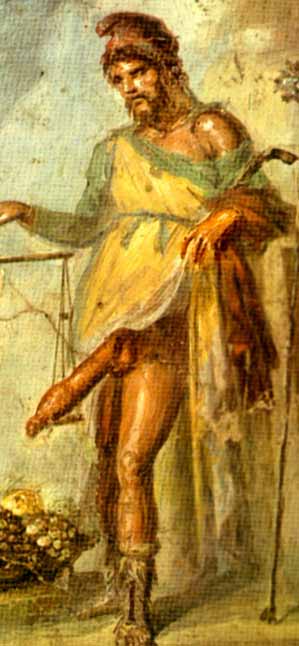 One of the more common examples of wall paintings is the one of Priapus. Priapus was the god of fertility and in the image, is weighing his penis against a money sack.
Behind him is a basket full of fruits. The painting is found in the entranceway to the house and one can conclude that not only did the Vettii want this
image to be visible, but that, since the society was so obsessed with status, this image might highlight some quality the Vettii believed they had, or strived to achieve.
A statue of Priapus is also found in the garden. Clarke notes that "Priapus' phallus wards way the Evil Eye."[20]
One of the more common examples of wall paintings is the one of Priapus. Priapus was the god of fertility and in the image, is weighing his penis against a money sack.
Behind him is a basket full of fruits. The painting is found in the entranceway to the house and one can conclude that not only did the Vettii want this
image to be visible, but that, since the society was so obsessed with status, this image might highlight some quality the Vettii believed they had, or strived to achieve.
A statue of Priapus is also found in the garden. Clarke notes that "Priapus' phallus wards way the Evil Eye."[20]
Cupid on a Crab
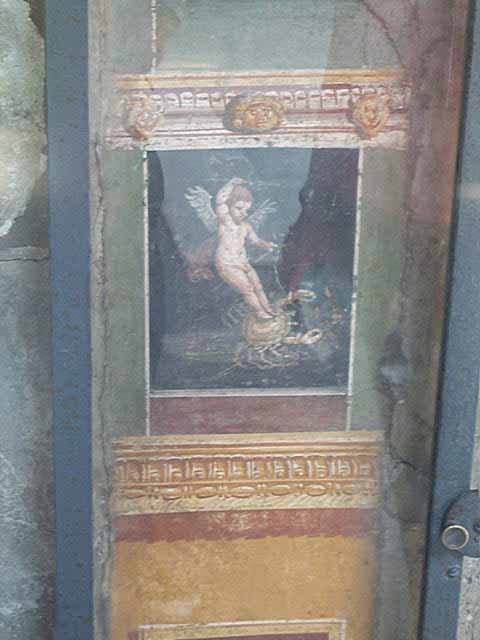 It has been suggested that the juxtaposition of the cupid on top of the crab represents the
dependence the people of Pompeii have with the sea, as many of them were merchants, especially the Vettii.[24] This specific painting can be
found in the atrium. Cupids were seen throughout the house,
and in many instances, were seen in work scenes, as can be seen in the second image found elsewhere in the house.
It has been suggested that the juxtaposition of the cupid on top of the crab represents the
dependence the people of Pompeii have with the sea, as many of them were merchants, especially the Vettii.[24] This specific painting can be
found in the atrium. Cupids were seen throughout the house,
and in many instances, were seen in work scenes, as can be seen in the second image found elsewhere in the house.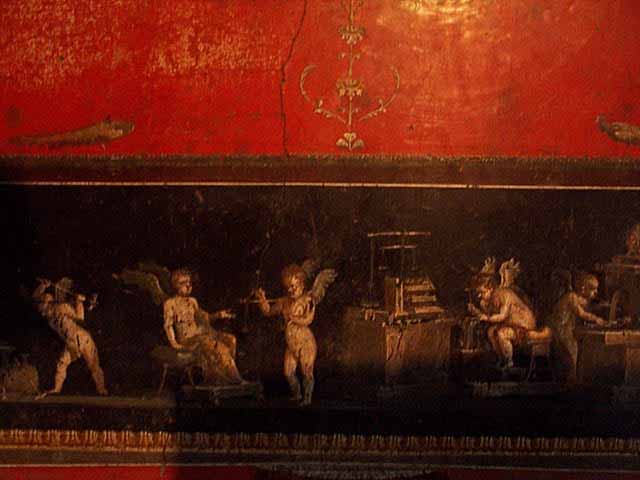
Male and Female on Bed
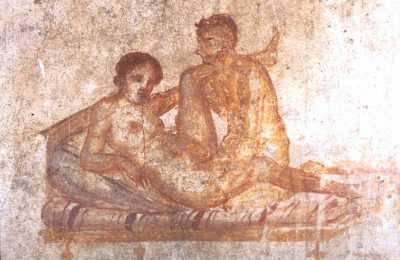 Found in room x' are paintings featuring intercourse. The location chosen to have such images was considered bizarre by
Clarke as it was near the kitchen. Clarke also points out
the fact that throughout the whole house, paintings have incredible amounts of details, while these images are quite simple.[25] What Clarke also
notes that puzzles historians is that these images are very different from the sexual images seen in similar houses, and are in fact more like the ones found in brothels. Clarke goes
on to explain that, since the area was in the servants quarters, it was not likely that the area was used as a brothel. He gives multiple reasons for this including the fact that the
Vettii did not carry out business in their home, and the fact that it was not a very profitable business to begin with.[26] Clarke did point out the fact that,
since the Vettii were former slaves, they might have designed the room so that it would make one of their slaves lives more pleasurable.[27]
Found in room x' are paintings featuring intercourse. The location chosen to have such images was considered bizarre by
Clarke as it was near the kitchen. Clarke also points out
the fact that throughout the whole house, paintings have incredible amounts of details, while these images are quite simple.[25] What Clarke also
notes that puzzles historians is that these images are very different from the sexual images seen in similar houses, and are in fact more like the ones found in brothels. Clarke goes
on to explain that, since the area was in the servants quarters, it was not likely that the area was used as a brothel. He gives multiple reasons for this including the fact that the
Vettii did not carry out business in their home, and the fact that it was not a very profitable business to begin with.[26] Clarke did point out the fact that,
since the Vettii were former slaves, they might have designed the room so that it would make one of their slaves lives more pleasurable.[27]Woman on Man
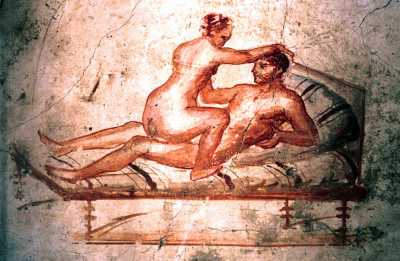
woman on man
Significance of Snakes[28]
Detail of Serpents
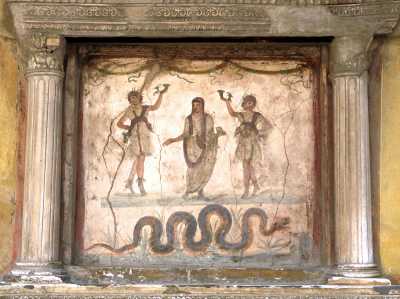 It was quite common to find depictions of serpents on shrines in Pompeii. Sometimes there might be two that face
towards each other symmetrically, or a single serpent. The same imagery is frequently found on public shrines.
Religion experts have come up with strong theories as to why such an image is chosen. The conclusion was that the serpent was a symbol of genius. Therefore, as the shrines
are in homes, the serpents represent the intellect of the homeowner. When there are two serpents present, the second represents the wife.
This theory has yet to be proven based on actual artifacts rather than collective assumptions.
The House of the Vettii presents an interesting twist as there is only one serpent on the shrine, though two men lived in the house, but both were also unmarried.
While the reason for the quantity of serpents still goes unknown, an inscription on a painting in Herculaneum further solidified the connection between serpents and genius. In a
painting elsewhere in Pompeii, two serpents attack a man who is defiling a sacred spot. From this, one can assume that
individuals believed the serpent, in particular, could protect the purity of their sacred space.
It was quite common to find depictions of serpents on shrines in Pompeii. Sometimes there might be two that face
towards each other symmetrically, or a single serpent. The same imagery is frequently found on public shrines.
Religion experts have come up with strong theories as to why such an image is chosen. The conclusion was that the serpent was a symbol of genius. Therefore, as the shrines
are in homes, the serpents represent the intellect of the homeowner. When there are two serpents present, the second represents the wife.
This theory has yet to be proven based on actual artifacts rather than collective assumptions.
The House of the Vettii presents an interesting twist as there is only one serpent on the shrine, though two men lived in the house, but both were also unmarried.
While the reason for the quantity of serpents still goes unknown, an inscription on a painting in Herculaneum further solidified the connection between serpents and genius. In a
painting elsewhere in Pompeii, two serpents attack a man who is defiling a sacred spot. From this, one can assume that
individuals believed the serpent, in particular, could protect the purity of their sacred space.